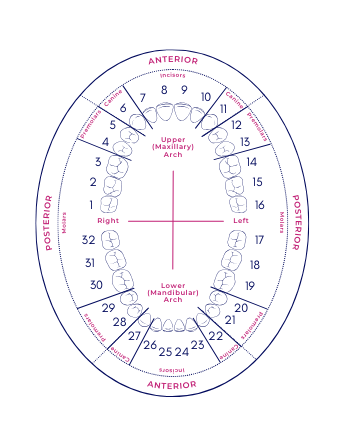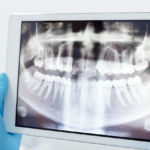Your mouth, it’s used for eating, to determine if you like or dislike certain foods such as brussel sprouts. It is used for drinking your favorite artisanal coffee drink in the mornings, workout shakes before gym, water to stay hydrated, or that well deserved (or much needed) glass of wine at the end of a workday. You use it for talking, even in situations where discretion may be advisable, Karen. You’re even using it right now as you read this and will continue to use it 24/7 for breathing. Those are the four main functions of the mouth: eating, drinking, talking and breathing. Now imagine how hard those activities would become with little to no teeth.
Your mouth is an irreplaceable and integral part of your digestive system, allowing you to eat, drink, talk, and breath. But what exactly makes up the oral cavity? The oral cavity includes the lips, vestibule, mouth cavity, gums, teeth, hard and soft palate, tongue and salivary glands. Each of these components work together to enable the functions of the mouth.
- Lips – muscular structures at the entrance to the mouth, transitioning from skin to mucous membrane.
- Vestibule – space between soft tissue (lips and cheeks) and teeth and gums, kept moist by parotid salivary gland secretions.
- Mouth cavity – bounded by alveolar arches containing teeth, hard/soft palates above, and tongue below. Submaxillary and sublingual salivary gland secretions keep it moist.
- Gums – dense fibrous tissue lining alveolar arches and surrounding teeth.
- Teeth – two sets: 20 primary (baby) teeth replaced by 32 permanent (adult) teeth by about age 21.
- Palate – hard (bony roof) and soft (membrane fold) portions, with uvula at the back of the throat.
- Tongue – mostly muscle, divided into oral and pharyngeal sections, important for taste, speech, and swallowing.
- Minor salivary glands – found in various locations around the mouth, producing saliva to moisten and break down food
Most won’t understand the importance of your oral health until faced with the possibility of no longer having teeth. 36 teeth may sound like a lot, and missing one or two teeth isn’t the end of the world. Most dentists and orthodontists even recommend extracting your wisdom teeth, so you’re probably already down to 32.
 But you need to understand your teeth are a community in itself. They work together, support and keep each other in place. When a space opens up, your teeth will naturally start to shift, leading to a change of how your teeth fit together and how you chew your food. Without your molars, the back four teeth, eating will become difficult. Resulting in more stress and pressure on your remaining teeth that aren’t designed for the grunt work of chewing. Potentially leading to the tooth structure wearing down, fracturing, and dental decay. That is just the immediate effects.
But you need to understand your teeth are a community in itself. They work together, support and keep each other in place. When a space opens up, your teeth will naturally start to shift, leading to a change of how your teeth fit together and how you chew your food. Without your molars, the back four teeth, eating will become difficult. Resulting in more stress and pressure on your remaining teeth that aren’t designed for the grunt work of chewing. Potentially leading to the tooth structure wearing down, fracturing, and dental decay. That is just the immediate effects.
Imagine having to miss out on your favorite foods such as steak, hard shell tacos, or chicken fried steak. I’m starting to get hungry writing this. Now imagine how hard those activities would become with little to no teeth. To live on a diet of soft foods and liquids, never to truly enjoy your favorite meal again. Not even death row inmates are denied their choice of a last meal.
As Times Goes By, the effects of tooth loss can have a domino effect on your body:
- Loss of dental stability
- Bone loss: Chewing helps maintain the strength of the bone that supports your teeth. When a tooth is lost, the supporting bone begins to atrophy, which can make dental implants and other restoration options more difficult in the future. If it has been a while since you lost a tooth, your bone may have significantly degenerated.
- Gum recession: When the bone shrinks due to a missing tooth, the gum tissues also shrink and become thinner and more delicate. Thinning gums are easily inflamed and injured by dentures and false teeth.
- Change to facial appearance: Missing teeth can accelerate facial aging and cause changes to your lips, chin, and nose, making you look up to 10 years older. Many people mistake these changes for aging rather than recognizing them as a result of tooth loss.
- Chewing difficulty: Denture wearers or individuals with missing teeth often face difficulties when eating certain foods.
- Lack of nutrition: Missing teeth can result in a lower intake of fruits and vegetables, leading to missing nutrition. Poor chewing performance may also impact digestion, resulting in inadequate absorption of nutrition.
- Change in speech: Missing teeth can impact speech, causing patients to experience changes such as slurring, lisping, or spitting. In some cases, the tongue may also enlarge as a result of missing teeth, further affecting speech.
- Decrease in confidence: Missing teeth can have a negative impact on both appearance and self-esteem, causing embarrassment and discomfort.
- Decrease in quality of life
Hopefully you’re starting to rethink skipping brushing before bed or before heading out to work due to a late start?
Good dental hygiene and oral care habits are essential for maintaining good oral health and overall health. We recommend brushing twice a day, once in the morning and again in the evening, using an electric toothbrush for a more consistent clean, and avoiding rinsing after brushing. Remember that taking care of your oral health not only ensures that you can continue to enjoy your favorite foods and maintain your appearance, but also prevents more serious health problems down the line. So, take action today and make good dental hygiene a priority in your daily routine!





